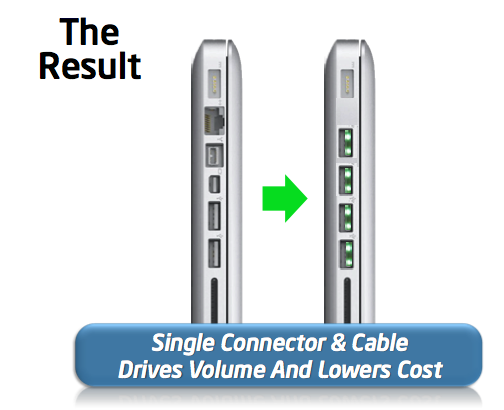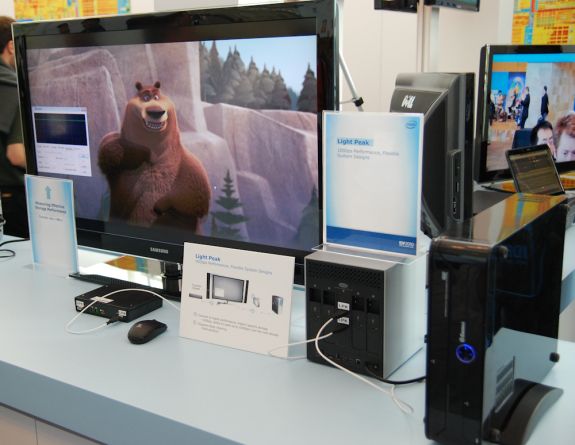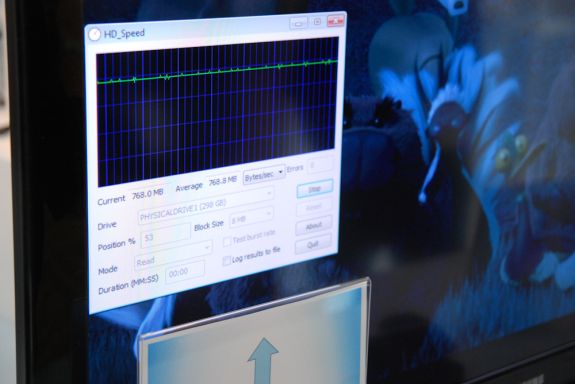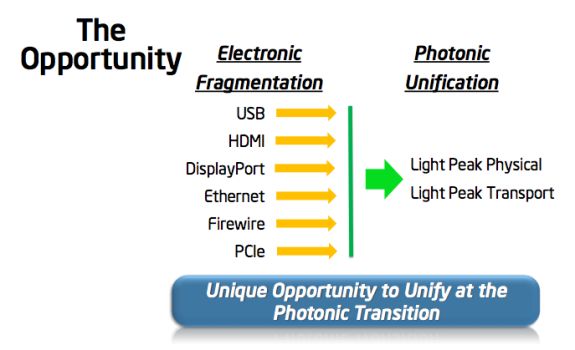Intel Light Peak - Lighting up 10 Gbps links in 2011
by Brian Klug on September 16, 2010 3:40 PM EST- Posted in
- Trade Shows
- Intel
- LightPeak
The second demo involved a desktop PC with Light Peak connecting to a modified LaCie 4big Quadra, daisy chained to another display with a built in HDMI adapter. Note that Light Peak supports daisy chaining as this demo was connected, but also supports a star topology like USB does.
At the far left on the TV was the total bitrate of the storage system, which showed a solid 768.8 megabytes/s of throughput. That's 6.15 gigabits per second of throughput. Obviously the video must have been uncompressed to achieve such high bitrate, but the display itself was only 1080P.
Both of these demos really show how close Intel is to finalizing Light Peak for consumer consumption, and how closely they've been working with partners like Western Digital and Avid for having devices ready eventually.
Obviously USB will live on for years, and USB 3.0 still isn't completely ubiquitous, but the allure of using a single connection and cable for everything sometime in the future is hard to pass up.
The Tech
I spoke with Jason Ziller - Intel's director of Optical I/O planning - about what's left for Light Peak before we can all start enjoying one superfast desktop connection. Availability was originally slated to be Q4 2010, that date has now slipped to sometime inside 2011.

Remember that USB-like port? It actually is USB, but that's only for ease of testing until Light Peak's new connector is finalized. The connector won't look like USB, and obviously will have something unique to mitigate both alignment and potential damage to the interface. Intel isn't ready to say what this looks like, but obviously the connector will be subject to the same kind of scrutiny that USB was for durability and consumer friendliness.
Light Peak isn't a protocol, but instead simply provides a new physical layer for existing connector protocols. Traffic like DVI-D, HDMI, USB, and audio can all coexist across Light Peak.
Intel didn't need to use WDM (Wavelength Division Multiplexing) to achieve 10 Gbps as demonstrated, and maintains that although WDM could be used in the future to increase bandwidth, there are other ways to scale to 100 Gbps. Currently Light Peak is 100 meters capable, though the actual product will be 50 meters of distance. Cables have sufficiently small bend radius that they can be wrapped in a knot or around a pencil without the connection losing connectivity, and up to 7 devices can be daisy chained.
Interestingly, Intel is using an 850 nm wavelength laser for the system, and (unsurprisingly) multimode fiber. Data is bidirectional across the interface as well. 850 nm is a rather interesting choice, as it's still subject to class 1 eye safety limits (just above -4 dBm), but moreso because it was the wavelength used in some of the world's very first long haul fiber optic networks.
Intel's silicon photonics remain a separate project from Light Peak, as Light Peak uses VCSEL laser diodes. The long term vision is to eventually bring the two together in a much broader scope to bridge datacenters together instead of just desktops.
There's a lot of potential for the future of desktop optical interfaces - Intel just has to deliver them. Let's hope it happens in 2011 as promised!













59 Comments
View All Comments
AnnonymousCoward - Friday, September 17, 2010 - link
"fiber optics is just the way to go"No, COST is just the way to go. Note that whoever created DisplayPort chose to go the route of up to 4 PCIe lanes rather than fiber optics.
jordanclock - Friday, September 17, 2010 - link
One cable type means you'll have a bunch of ONE type of peripheral connector on your computer that can connect to ANY Light Peak peripheral. It doesn't care what protocol it uses, just the connector needs to be right. I really like the idea of having a dozen or so Light Peak connectors on my computer and just plugging in devices without a second thought. I don't like have a dozen connectors, only four of each variety and needing more of one type.Fiberoptic is the only economical way to achieve the kind of bandwidth needs we're moving toward and keep cable lengths long. Remember, Intel already demonstrated a 100Gbps version. That kind of cable could handle just about anything you can throw at it, making it perfect for everything from an audo connector, display connector, or for mass storage devices. I'd love to be able to pick up an external drive with a couple TB of storage in a RAID and be able to feed it data as fast as it could write it. And then use the same connector to hook up my HD camera to unload videos as fast as it can read them.
AnnonymousCoward - Friday, September 17, 2010 - link
"I'd love to be able to pick up an external drive with a couple TB of storage in a RAID and be able to feed it data as fast as it could write it. And then use the same connector to hook up my HD camera to unload videos as fast as it can read them."Well good, then you'd love to use the USB standard!
You brought up the issue of speed, as if LP enables higher transfer speeds. It doesn't, as it uses existing protocols. And you said audio cable--that will remain analog for most people.
AnnonymousCoward - Friday, September 17, 2010 - link
To help you understand, consider this. DVI has many parallel data pins. These would be fed into a DVI-LP bridge, light would be transmitted through the cable, and there'd be another LP-DVI bridge in the monitor, where it's then spread out to the parallel pins that the monitor system is ready to handle. LP adds no speed.iwodo - Thursday, September 16, 2010 - link
That is not enough for DisplayPort 1.2. Not to mention the higher resolution monitor that are coming out when Lightpeak are available, and the need for 120hz 3D Display.While i would love a new and improved connector. ( I hate the way USB allows you to plug in upside down ). Sticking to USB connector would make more sense given the huge amount of devices using it such as USB memory. The Cooper left inside could be used to power transmission.
wisecracker - Saturday, September 18, 2010 - link
Huh? There's a barrel maker inside each of my USB connectors? And now you are suggesting they can be put to work with LightPeak as well? Truly amazing!Seriously though, the confusion for many that would result from having USB connectors that aren't actually USB connectors would be too much. I doubt even color coding would suffice.
ravin511 - Friday, September 17, 2010 - link
The power is coming from the HDMI cable. The HDMI cable has 5V power inside it.Metaluna - Friday, September 17, 2010 - link
"Interestingly, Intel is using an 850 nm wavelength laser for the system"This doesn't seem that unusual when you consider that 850nm multi-mode fiber is commonly used for 10gig Ethernet (e.g. XFP modules), so it's probably readily available and cheap. The fact that it's not entirely eye-safe is kind of interesting though for a consumer-grade product, though I'm sure it's running at very low power. I guess the fact that the entire optical path is sealed inside the cable makes it safe enough, unless you go staring into the end of a broken cable.
gnesterenko - Friday, September 17, 2010 - link
Because this is an Intel product, they may decide to cut AMD out of the picture. If AMD can't get lightpeak into its chipsets, and its as good as they say it is, that would be a heavy blow. Hopefully they can't extend that too far and will allow 3rd party chips like USB3 is now on mobos... Otherwise all I can do is yell "monopoly"..."The views expressed here are mine and do not reflect the official opinion of my employer or the organization through which the Internet was accessed."
Guspaz - Friday, September 17, 2010 - link
All the early LightPeak connectors are based on USB, which gave me great hope that LightPeak would be backwards compatible with USB. After all, Intel's intention is to replace all connectors with LightPeak... using a new connector will render every USB device on the market incompatible.Yes, I realize that there is a transition period here, where we'll get a few LightPeak connectors to start out with, but breaking backwards compatibility is just plain dumb. For one thing, some peripherals just don't NEED optical connections. Does my keyboard really need a 10Gbps optical connection, driving up costs? No! Maintaining backwards compatibility with USB would have not only allowed all existing peripherals to continue working, it would have allowed lower cost devices to avoid using optical when they don't need it.
Look how long it's taken us to transition from PCI to PCIe. PCI-Express was introduced in 2004. SIX years ago. And even today, most motherboards still ship with regular PCI slots because there are still devices that use PCI on the market. PCI NICs are still cheaper than PCIe NICs.
Now, PCI was never nearly as widely used as USB. Many computers didn't even have any PCI cards, since lower-end motherboards tended to build video/audio/etc into the chipset. On the other hand, everybody out there has multiple USB devices plugged into their computer. If we still haven't fully transitioned off PCI six years later, can you imagine how long killing off USB is going to take?
This was such a great opportunity for Intel to create the successor to USB. Instead, they've decided to create the usurper. And that's very unfortunate.